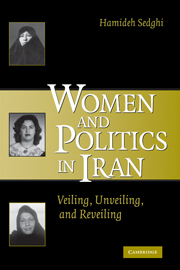Book contents
- Frontmatter
- Contents
- Acknowledgments
- Transliteration and References
- Introduction
- PART I WOMEN IN EARLY TWENTIETH-CENTURY IRAN
- PART II WOMEN IN THE KINGDOM OF THE PEACOCK THRONE
- 2 The Pahlavi Dynasty as a Centralizing Patriarchy
- 3 Economic Development and the Gender Division of Labor
- 4 The State and Gender: Repression, Reform, and Family Legislation
- 5 Women and the State
- PART III WOMEN IN THE ISLAMIC REPUBLIC OF IRAN
- Conclusion
- Glossary
- Selected Bibliography
- Index
4 - The State and Gender: Repression, Reform, and Family Legislation
from PART II - WOMEN IN THE KINGDOM OF THE PEACOCK THRONE
Published online by Cambridge University Press: 22 August 2009
- Frontmatter
- Contents
- Acknowledgments
- Transliteration and References
- Introduction
- PART I WOMEN IN EARLY TWENTIETH-CENTURY IRAN
- PART II WOMEN IN THE KINGDOM OF THE PEACOCK THRONE
- 2 The Pahlavi Dynasty as a Centralizing Patriarchy
- 3 Economic Development and the Gender Division of Labor
- 4 The State and Gender: Repression, Reform, and Family Legislation
- 5 Women and the State
- PART III WOMEN IN THE ISLAMIC REPUBLIC OF IRAN
- Conclusion
- Glossary
- Selected Bibliography
- Index
Summary
“I don't underestimate [women], as shown by the fact that they have derived more advantages than anyone else from my White Revolution,” stated the Shah. Whether or not the monarch was sincere when he said so, he was taken at his word by the Ayatollah Khomeini who denounced the Shah's reforms and Family Protection Laws as “anti-Islamic.” They were “intended for the break-up of Muslim families,” maintained the Ayatollah. Those responsible for the laws are “condemned by Islam; women who utilize those laws and divorce are not legally divorced and if they remarry, they are adulterous and their children are illegitimate and disinherited. …”
The White Revolution marked an intense state-clergy strife that temporarily led to the supremacy of the state over religion but also over its secular opponents. Although the clergy did not uniformly oppose the state, the Shah succeeded in winning over the religious opposition while himself appropriating more firmly the ideological imagery of “God, the Shah, and the nation.” Proclaiming that his reforms exemplified “justice and equality,” he claimed they were compatible with the “true religion of Islam.” Through women's suffrage and his gender policies, enacted despite the clergy's jurisdiction over family and gender relations and their opposition, the Shah promoted his modernizing posture, especially in the Western hemisphere. In his legal reforms, he was more triumphant than his father in shaking the power of the religious establishment by depriving it of a major source of strength over nearly thirteen centuries: the theoretical, and to a lesser extent, the actual privatization and control of women.
- Type
- Chapter
- Information
- Women and Politics in IranVeiling, Unveiling, and Reveiling, pp. 128 - 151Publisher: Cambridge University PressPrint publication year: 2007

